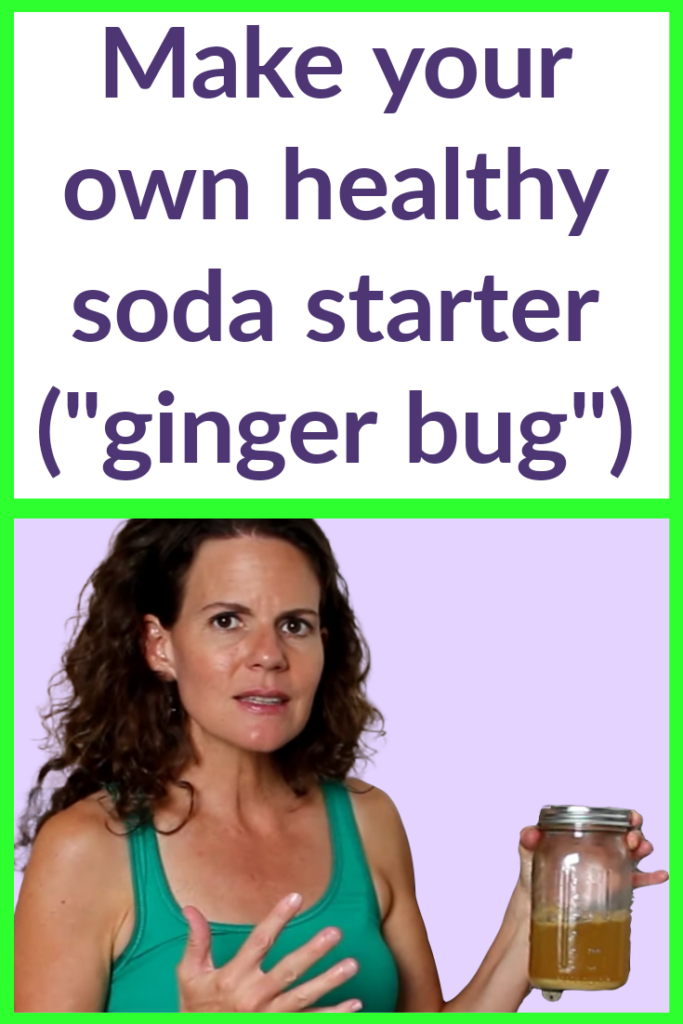Table of Contents[Hide][Show]
How to make a starter culture “ginger bug” for homemade soda with just three ingredients and a little love from Mother Nature!

Investigation of the culinary practices of Ancestral Societies from around the world reveals that nearly all of them utilized various types of fermented foods. This practice assisted digestion, maintaining a healthy balance of gut bacteria to keep immunity strong.
Of course, these cultures did not understand the science behind the benefits of fermented foods. They only observed anecdotally that by eating these foods regularly, vibrant health was more easily maintained and chronic disease avoided.
We now know that traditionally prepared fermented foods contain an abundance of beneficial bacteria, enzymes, and nutritional co-factors not present in the unfermented version of the same foods. Regular consumption of traditionally fermented foods makes it far more likely that you and your family will sail through flu season with nothing more than a mild sniffle or a brief fever if even that!
Tasty, traditional ethnic beverages are a fun way to begin the process of incorporating fermented foods into your home. Kombucha was the first traditionally fermented beverage I started with nearly 2 decades ago. It is still a regular feature in our refrigerator. In fact, I am using a descendant of the same culture I purchased in 2002. This demonstrates that once you have a quality starter culture for a particular fermented food, it can literally last a lifetime. You can even pass it on to your children!
What is a Ginger Bug?
Homemade sodas such as root beer, ginger beer, or ginger ale require a different type of starter culture. There is no need to buy one. You can easily create it yourself without a dime spent out of pocket.
You accomplish this by cultivating naturally occurring and highly beneficial lactobacilli and wild yeasts. Lactobacilli is present on the surface of all living organic matter and particularly abundant on the roots and leaves of plants.
These beneficial microbes easily grow in an appropriate fermenting medium at home. Then, you feed them over a period of a few days to achieve critical mass for a starter culture. You know that this “bug” is ready when bubbles appear. The inoculant is perfect for whatever soda recipe you wish to make.
Homemade Soda Starter Do’s and Don’ts
All you need is organic ginger powder (or fresh ginger), white organic sugar, and filtered water.
Do not use nonorganic ginger powder as this will likely have been irradiated. This destroys all beneficial microbes and will prevent the starter culture from “taking”.
Also, always use filtered tap water, because chemicals like chlorine and trihalomethanes in tap water will inhibit the growth of the beneficial microorganisms.
One more caution: be sure to use organic white sugar! Manufacturers usually blend nonorganic refined white sugar at least partially with sugar from GMO beets. This is true in North America unless the package specifically states that it is 100% cane sugar.
Don’t worry that you are using white sugar, as this is feeding/growing the beneficial microbes, it’s not feeding you.
Learning to harness the environment around us for the betterment of our health is a skill practiced by healthy Traditional cultures. Our modern germaphobic society remains mostly in the dark about this valuable knowledge. Fortunately, more people are realizing and returning to the wisdom of these ancestral methods to regain their health.
The truth is not all “germs” are bad. Learning to harness the good ones, or probiotics, to fend off pathogenic strains that can easily take over in our gut is a wise practice through regular consumption of fermented foods and beverages.
The recipe below uses the traditional method from Nourishing Traditions Cookbook.
Need healthy homemade soda NOW? Try this easy soda recipe until your soda starter is ready!
Recipes to try with DIY Soda Culture
The video in the recipe below shows you exactly how to cultivate a “ginger bug” so that you have one ready to go when you decide to embark upon the adventure of homemade soda making.
Refer to my recipes on homemade root beer and ginger ale once your DIY starter is ready to use!

Recipe for Homemade Soda Starter ("Ginger Bug")
How to make a starter culture for homemade soda so you can enjoy this traditional beverage with no downside and no extra money spent to buy one!
Ingredients
- 10-14 tsp ground ginger must be organic
- 10-14 tsp white sugar preferably organic
- 1.5 cups fltered water
Instructions
-
Fill a quart mason jar with 1 1/2 cups filtered water. Add 2 tsp ginger powder (or grated, fresh organic ginger) and 2 tsp organic white sugar and mix well. Cover and leave on the counter at room temperature for 24 hours.
-
After 24 hours, remove the lid and add an additional 2 tsp ginger powder and 2 tsp white sugar and mix again. Cover and let sit on the counter for 24 more hours.
-
Repeat for a minimum of 3 days and for a maximum of 7 days until small bubbles begin to form on the top indicating the probiotic culture has reached a critical mass and taken hold. Once the bubbles appear, the liquid excluding the sediment on the bottom of the jar can be used as a starter for homemade sodas. Refrigerate and feed the culture 2 tsp ginger powder and 2 tsp sugar once a week if not used within a few days.
-
If no bubbles appear by the seventh day, toss and start again.
Recipe Video
Recipe Notes
Fresh, grated organic ginger may be substituted for ground ginger. The equivalent amount would be roughly one-third.
If using ground, you MUST use organic as conventional ground ginger is irradiated.
It is best to use organic sugar, as nonorganic white sugar is most likely genetically modified or GMO.









When I was a young girl, my grandmother used to make the most delicious “fermented” drink (I didn’t know back them about beneficial bacteria) which the kids consumed like crazy on hot summer afternoons. It was made with pineapple, fresh, from the farm. There were three rules: The pitcher need to be a glass pitcher; the water must be spring water, fresh pineapple (in those times allof our produce was organic, so make sure you get organic pineapple, free of pesticides). Simpy:1) Wash your pineapple with clean water. Make sure your last rinse is with spring water since you will use Only the skin of the pineapple. 2) Peel the pineapple, reserving all the pineapple peel/skin. 3) Place the pineapple peel/skin Only in the glass pitcher. 3) Fill the glass with spring water. 4) Use a piece of cloth to cover the pitcher, wrapping an elastic band around it to keep it in place. 5) Set the pticher in a dark corner at room temperature for 3 days. You should get a fermented drink, with some “foaming” on top. How warm the room where you store the drink is important; it should not be in a cool room. 6) Strain the water through a mesh strainer to colect any sediments, add sugar and stir. Serve in a tall glass filled with ice. Delicious! We used to call this drink: Guarapo de Piña So now you know, each time you serve pineapple to your friends and family, Do Not throw away the skin, make a Guarapo instead. Enjoy!
Hi Sarah, does the culture go back into the fridge right after feeding (when not being used)? Thanks, Jennie
I have organic dried ginger root, not powder, could I use that to start the ginger bug? Also would well water be fine to use? Thanks for all you do! You are such an inspiration, and a household name 🙂
I have not tried dried ginger root .. only the organic ginger powder and freshly grated ginger. Try it and see and let us know!
I’ve been looking for something like this, thank you!
BTW, you have a typo here: “Once the bubbles appear, the liquid excluding the sentiment on the bottom of the jar can be used as a starter for homemade sodas.”
Of course, it should be “sediment,” not “sentiment.” 😉
Thank you 🙂 Will fix that now.
I love the smell and taste of ginger, the only thing that concerns me is that its very strong. How does this taste, knowing full well that its subjective. I don’t want to go to all the trouble just to find out its too powerful.
You won’t be drinking this starter … it is the probiotic inoculant for a homemade soda.
oops, I’m embarrassed now, starter not the actual drink, got it.
What about the alcohol content in fermented drinks? We make homemade kefir but is giving it – full glass to my 2 year old fine on a daily basis?
When I hear “soda”, I think “sweet”. Is there ANY sugar left in the final product? Some of the kombuchas on the market can be quite high in it. Do you know how many grams are left in the final product, per 8 oz. for example? Thank you!
I’m sure there is some sugar left … this recipe is NOT soda however. It is the starter that will be used for a homemade soda recipe. Remember that sugar is not bad .. it is only bad when consumed in nutritionless, refined fashion or when consumed to excess. Moderate consumption of whole sugars is fine .. remember that we have sugar sensing tastebuds. We are meant to sense and enjoy sweetness as practiced by traditional cultures.
Sarah
So happy to see you doing videos again. Most of the traditional recipes I do today, I learned by watching your videos and now I am teaching others. After 2’years, I have gotten a wonderful sourdough bread perfected and I want to make a video showing how I make it. Thank you! Keep up the recipes and wonderful videos. I know I am not the only one who enjoys them:)
Yes, it sounds like it is fermented. You can drink it as is. That’s fine.
I have been making a ginger/turmeric/lemonade with coconut sugar. Sometimes I make such a big batch, I don’t get it all drunk in one day and I leave it out on the counter. I’ve noticed that by day 3 it is fizzy on top, especially when I’ve added fresh pomegrante seeds. It sounds like it’s growing these good microbes you mention. Is there any reason I can’t just drink it like that or is it important to use it as a starter for something else? Thanks!
Hello Meg, please if you can, could you share your recipe with me? i like to use turmeric in my brew i know its very healthy and helps with inflammation which i have in my gut.
Thank you.
Nicole
Yes, I would love your recipe also…thanks, Meg…deeply appreciated.
Ellen
oops! I replied to Nicole instead of Meg, duh! 🙂
Yes, I would love your recipe also…thanks, Meg…deeply appreciated.
Ellen